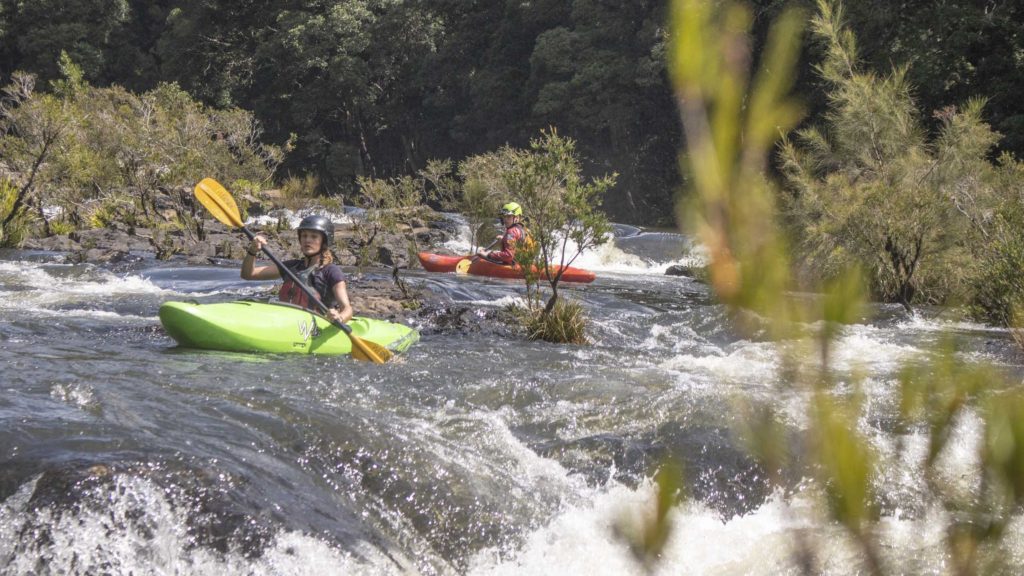These pages do not equip you with the skills to lead or go on a trip. The author and club accept no responsibility for the actions of those relying on the information herein. Outdoors activities are undertaken at an individual’s own risk. These pages contain general tips and advice. Use it as a guide to know what is advisable to have with you and what you should learn from appropriate courses and experienced leaders.
The kayaking trip leading tips on this page are designed to complement the main Trip Leading 101 page. Please see that page for general information on running any club trip.
What Skills Do I Need?
If you don't currently have all these skills, ask an experienced trip leader to teach you! Attend a club workshop, read widely or take a professionally taught course. However, to lead a kayaking trip you need to knowledge of:
- How to correctly hold the paddle and ways to launch.
- Boat parts (hatches and how to pack, lowering/raising the rudder/skeg, safety lines, etc.).
- Wet exits and emptying boats onshore.
- Rescues when some people remain in still upright (H rescue, X rescue, T rescue, Hand of God rescue).
- Self rescues/rescues when all people have capsized. Re-entry roll, paddle float entry.
- How to re-enter boat on the water - ways to stabilise/assist people on entry, and how to re-enter your own boat from the water.
- Towing
- Moving the foot blocks/seat in each boat type.
- Other gear - when to use and how to use it (float bags, sponge, lifejackets, spray decks, helmets, throwbags, foam blocks, etc.).
- Fitting club members/yourself into boats.
- Tiedown of boats, soft racks, etc.
- Paddle strokes (forward, backwards, draw, pry, sweep, low brace, high brace).
- Edging and edges in different boat types and between flatwater, whitewater and surf.
- Other things (right-of-way, paddling at night, sea sickness, rolling, hip flicks, landing, useful other gear, etc.).
Before the Trip:
- Ask each trip participant:
- Is the trip participant a confident swimmer?
- Whitewater:
- What relevant experience does the participant have on man-made and natural whitewater?
- How confident is the trip participant in rolling/has a trip leader seen them roll?
- Sea kayaking:
- What prior experience does the trip participant have in launching, landing and wet exiting?
- Ensure each trip participant has appropriate:
- Footwear
- Paddling clothing wetsuit/drytop/drysuit (if necessary)
- Food and water
- Drybag
- Additional thermals/warm clothing
- Emergency blanket
- Sunscreen
- Headtorch (+ spare batteries)
- PFD
- Float bags
- Skirt
- Boat
- Paddle
- Overnight gear (if required)
- And for whitewater trips:
- Helmet
- Whistle
- The trip leader is responsible for checking the securement of all boats when travelling.
Whitewater
- Trip leader must always carry a breakdown paddle, throw bag, river knife, sponge, PLB, first aid kit, boat repair kit and pin kit on rivers.
- Trip leader must always wear a rescue vest. Do not give trip participants a rescue vest unless they have prior experience with one.
Flatwater and Sea Kayaking
- Trip leaders must always carry a split paddle, PLB, first aid kit, towline, pump/sponge, and paddle float.
- Hatch covers must be properly secured before transporting boats. The gear officers should be alerted if hatch covers are missing.
Before Leaving the Cars:
Whitewater
- Brief all trip participants on the paddle signals.
Sea Kayaking
- Brief all participants on maritime right-of-ways.
During the Trip:
Whitewater
- Safety must be set for all blind rapids, or rapids with perceived hazards.
Flatwater and Sea Kayaking
- Trip participants must practice a wet exit before using a spray skirt if they cannot competently roll the kayak.
After the Trip:
- Coordinate the expected care of boats (wash everything, dry everything, what to hang and dry, what to put away).
Do your best to be safe out there, learn as much as you can, accompany experienced leaders and of course, have fun 🙂






